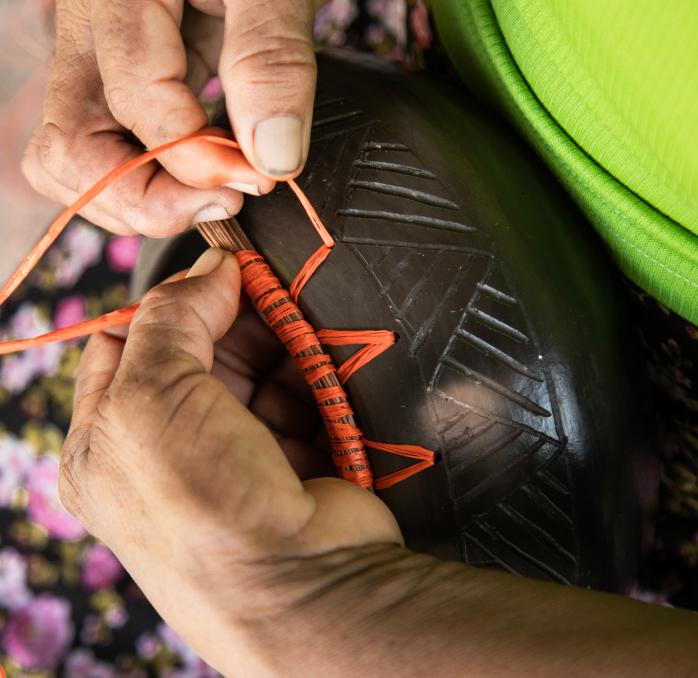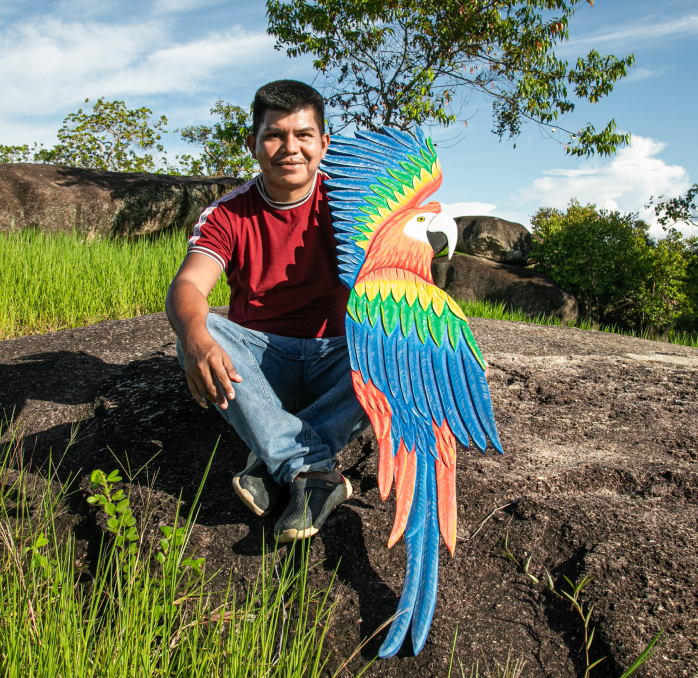Nancy Torcuato
Workshop: Sipada
Craft: https://www.google.com/maps?cid=3429124506334809666
Trail: Guainía Route
Location: Inírida, Guainía
SCHEDULE YOUR VISIT
Comunidad de Coco Viejo (en moto carro 10min) hacia el batallón, Parque rupestre Amarrú, Puerto Inírida, Guainía
Nancy: 3212310428
Melvino: 3112410234
Nancy fondly recalls her grandmothers as the ones who initiated her into the realm of artisanal craftsmanship. Her paternal grandmother, Barcelisa, used to regale her with stories about the origins of clay. Nancy’s memory of her is vivid; she can still see Barcelisa returning home laden with black clay she had collected during the dry season in Inírida, between November and January. Nancy vividly recalls her grandmother’s hands expertly shaping jars for storing chicha, a fermented beverage, crafting plates for dining, and fashioning budares for roasting mañoco and casabe on a broad cooking plate. Barcelisa not only presented pottery to Nancy but also passed on her skills to her. Conversely, her maternal grandmother, Carolina, introduced her to chiquichiqui fibers and guided her in the art of weaving. Both mentors played pivotal roles in shaping Nancy into the craftswoman she is today, merging techniques from both worlds.
Speaking of her Curripako culture, Nancy often references Amaru, the warrior credited with birthing Kuwai, the god central to their cosmogony. Kuwai’s body emits an animalistic melody, depicted in Nancy’s crafts as a tribute to Curripako women. She describes these women as strong, independent individuals who derive their livelihood from craftsmanship. The foundational myth, depicting women without vaginas, is startling and symbolic, portraying these women’s determination to tackle any challenge independently, even the creation of life itself.
Surrounded by a breathtaking landscape replete with rivers and stones adorned with petroglyphs, Nancy finds inspiration in the ancient markings etched by the inhabitants who dwelled in these lands millennia ago. These symbolic tales etched on stones now find a place in Nancy’s crafted goods. Her husband, Melvino, becoming a guide at the Amarrú Prehistoric Park, is a source of immense pride for Nancy. Together, they safeguard their heritage, fully appreciating its value.
Nancy diligently preserves the traditional methods of her ancestors, blending clay with cabé ashes akin to her grandmother Barcelisa’s techniques, ensuring the clay’s desired consistency and successful firings. Employing ground rust from trees, she meticulously polishes her pieces and embellishes them with petroglyphs, serving as a reminder of the rich Curripako universe deserving protection. Utilizing moriche and chiquichiqui in her vessel weaving, she crafts pieces that are both innovative and aesthetically pleasing, showcasing high-quality workmanship.
She recounts her community’s evangelization between 1944 and 1965 by the American missionary Sofia Muller, whom her father and grandfather welcomed into their territory over seven decades ago. Muller imparted knowledge about Curripako culture and introduced Nancy’s community to other ethnic groups in Guanía, contributing to the prevalence of evangelical indigenous groups in the region today. As a successor to Muller’s legacy, Nancy actively organizes the Conference, an annual gathering where diverse communities share their spiritual experiences. Drawing around 500 attendees from the Atabapo, Orinoco, and Guainía rivers, as well as from Venezuela and Brazil, the conference stands as a significant event that receives the same level of dedication Nancy gives to her crafted goods.
Craft














Artisans along the way
Artisans along the way
No puede copiar contenido de esta página


























































